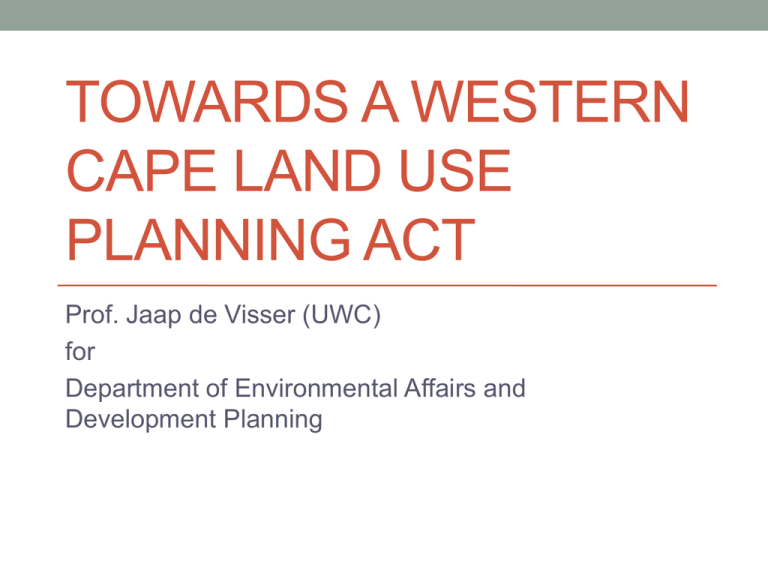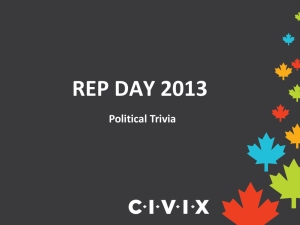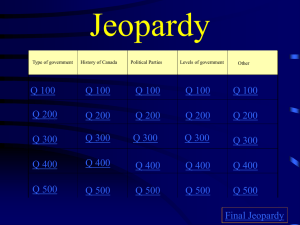TOWARDS A WESTERN CAPE LAND USE PLANNING ACT Prof. Jaap de Visser (UWC)
advertisement

TOWARDS A WESTERN CAPE LAND USE PLANNING ACT Prof. Jaap de Visser (UWC) for Department of Environmental Affairs and Development Planning Objectives of LUPA • establish firm link between forward planning and development • • • • management regulate municipal / provincial roles in land use planning facilitate ‘asymmetry’: a system that suits municipalities of varying capacity/resources find a way to deal with objections / IGR disputes – courts as last resort rationalise legislation, create mechanisms for ‘one stop’ application Debates • How to ensure alignment between provincial and municipal forward planning? • Can Province take decisions on specific land use applications or can it only adopt plans? • Municipal power to make by-laws on planning • What about the national Spatial Land Use Management Bill? Debate over forward planning • province wants leverage over forward planning at the level of municipalities • constitutional power over “provincial planning”, “urban and rural development”, “regional planning and development”, “housing”, “environment” etc. • municipalities want province to limit itself to province-wide planning, i.e. only a PSDF • municipal SDF (with urban edge) is part of “municipal planning” • Bill: integrated process towards one municipal SDF (with ‘a way out’ if conflict persists) LUPA on municipal SDFs • municipal and provincial officials jointly prepare one municipal SDF • • • • with 2 maps, dealing with municipal and provincial matters Municipal Council adopts SDF MEC certifies provincial map on basis of provincial grounds 1 plan reflecting province + municipal concerns Conflict? Land Use Planning Board recommends a solution to municipality Municipality rejects? municipality and province each adopt their own forward plan for that municipal area – both are binding Debate over provincial role in development management • Local government: • “CC’s DFA judgment implies that municipality decides on all applications, province may only regulate, support and monitor” • “province may not interfere with zoning schemes” • Province: • no, certain applications go beyond municipal interest (Lagoon Bay judgment) • “provincial planning” includes power to adopt zoning scheme dealing with matters of provincial interest • Bill: • integrated process towards one municipal zoning scheme (with ‘a way out’ if conflict persists) • municipalities decide on all applications but sometimes a provincial decision is also needed before development can happen LUPA on zoning schemes • municipal and provincial officials jointly prepare zoning scheme • Municipal Council adopts zoning scheme • MEC certifies zoning scheme on basis of provincial grounds ( 1 zoning scheme reflecting province + municipal interests) • Conflict? Land Use Planning Board recommends a solution to municipality • Municipality rejects? municipality and province each adopt their own zoning scheme for that municipal area, both are binding LUPA on land use applications • municipality receives, processes and makes a decision on all land use planning applications • only if the application (1) affects provincial interest and (2) municipality approves municipality must refer to MEC for provincial decision • developer then needs both approvals • criteria in s 2(4): • not on certified SDF, and • large scale OR impact on provincial functions • The Bill incentivises integrated approach to SDF and zoning scheme • process of joint preparation • pressure to arrive at one, instead of two plans/schemes • if certified SDF allows development no need to refer to MEC two-plan/scheme route should be exception referrals to MEC only in small minority of cases By-laws • municipality may adopt its own by-law to regulate “municipal planning” • by-law must comply with minimum standards of LUPA • public participation • role of registered planner • mechanisms for ‘one-stop’ application • time frames for decisions • objections to Board. • LUPA will include a ‘default by-law’ that (automatically) applies until municipality adopts by-law • Asymmetry: should work for both municipalities of various sizes/levels of capacity Objections and disputes • objections: • unsuccessful applicant • ‘angry’ neighbour • disputes between Province - Municipality: • dispute over SDF / zoning scheme • dispute as to whether MEC should approve a particular application • alignment of plans, etc. Debate about objections and disputes • Municipalities: • “objectors must use internal appeal, then go to court” • “current LUPO appeal = unconstitutional” • “refer IGR disputes to arbitration” • Province • internal appeal = inadequate, courts are expensive and inaccessible, need for alternative remedy for citizens Land Use Planning Board • perhaps, but recommendation by independent Board is not • Board will compose national and provincial nominees IGR dispute resolution LUPA on objections • aggrieved party may object against municipal/provincial land use decision to Land Use Planning Board • Board makes a recommendation • if applicable municipality confirms, revokes or amends its decision Expectation: • transparency, advice of independent review body and ‘paper trail’ should prompt responsible decision making National Spatial Planning and Land Use Management Bill (SPLUMB) • national must adopt by June 2012 (CC’s DFA judgment) • essential national minimum standards may prevail • draft of May 2011, Province argued for provincial discretion • constitutional duty to coordinate legislation (applies to province and national) • currently, LUPA not (always) aligned with May draft e.g. • no provincial development management authority (in first instance) • SPLUMB prescribes municipal tribunals with outsiders • no provincial certification of SDFs/zoning schemes • different treatment of appeals • different timeframes / review cycles etc. Thank you







